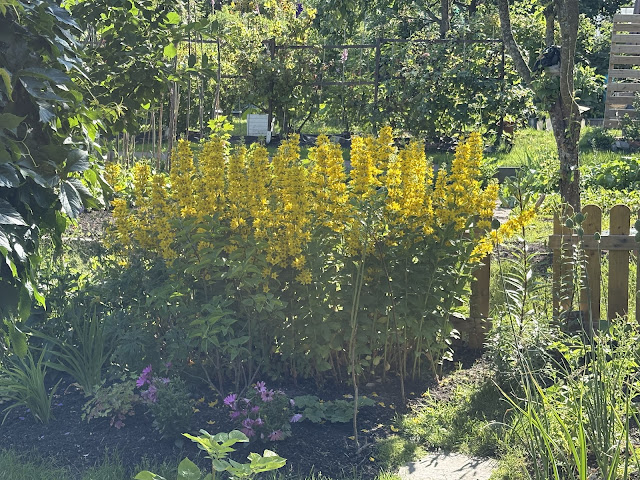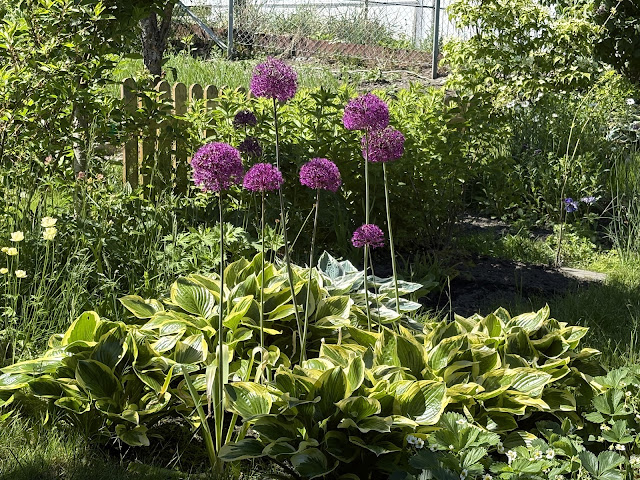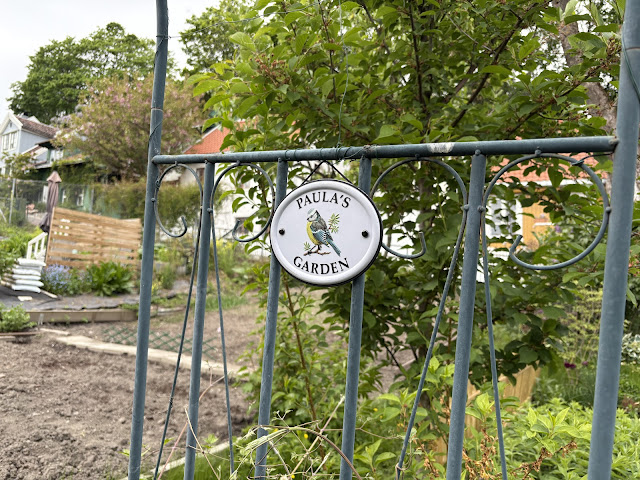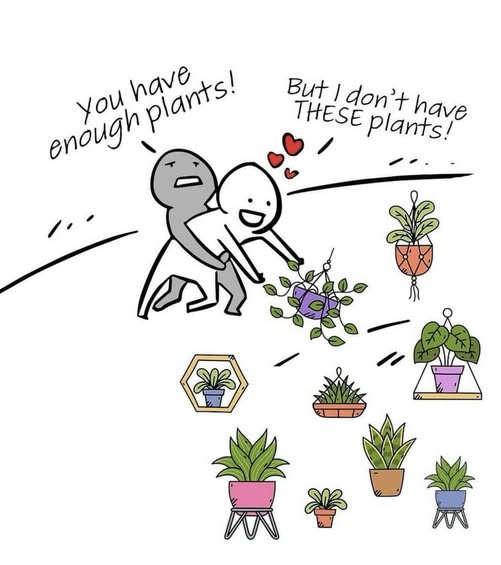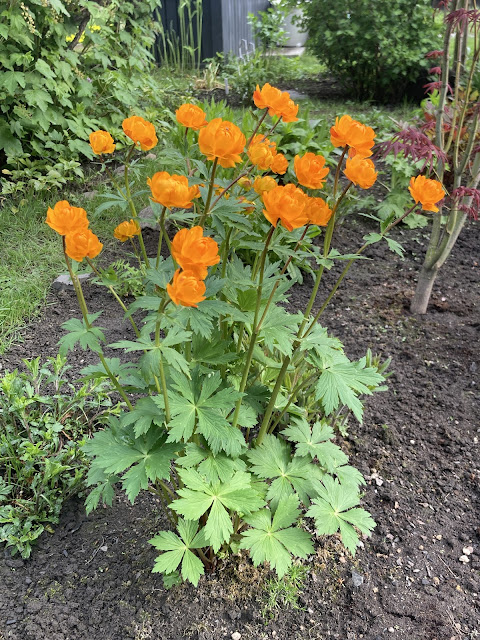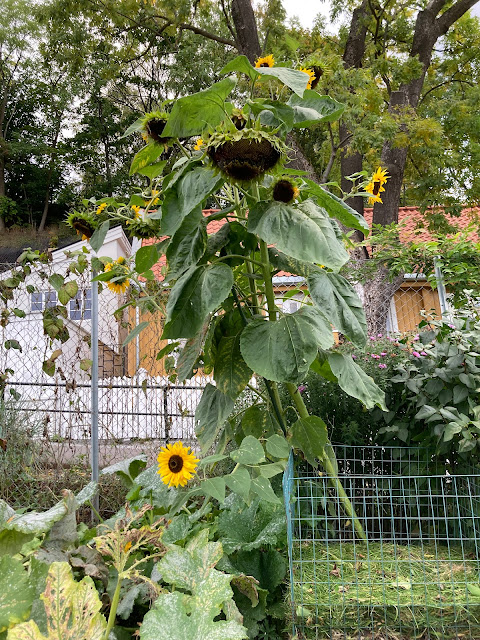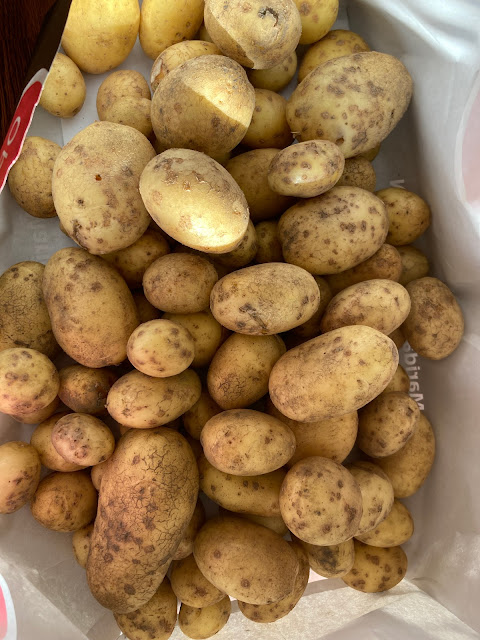The arrival of spring means the return of birds to the garden, birds of all kinds. Sparrows, brown and black thrushes, crows, magpies, wagtails, robins (the European ones that are smaller than the American ones), ring-necked doves, and (Eurasian) blue tits. Sparrows are most prevalent and spend most of their time in one of two huge bushes in my garden, the kaiser bush and the red currant bush which are more or less opposite each other. When I am working in the garden I can hear them quarreling and chattering; they fly back and forth between both bushes, with stops at the birdbath to drink water and to take a communal bath. Watching them flap around together in the birdbath is a hoot. And when it's really been hot during past summers, they share the birdbath with the bees that line up on the rim to drink water.
This year there is a large crow that saunters around the garden like he (she) owns the place. My garden neighbor calls her Clara, so we assume it's a female bird. Clara struts and shows off for us; she is not afraid of very much. It is the neighborhood cats that are scared of her; she has chased them out of the garden on numerous occasions. This year she has discovered my neighbor's small stone birdbath that has been placed at ground level. Clara and several of the magpies enjoy drinking water and plucking insects from this birdbath. It's amusing to watch them. She sometimes walks around my garden as do the brown thrushes, looking for insects (mostly earthworms) to eat. The brown thrushes remind me of little dinosaurs; I call them the little raptors. They have a menacing look in their eyes that strikes me as primeval.
As I walk to and from the garden, I pass Kiellands plass with its large pluming fountains whose water descends via small successive waterfalls into at least six small pools lined with smooth medium-sized stones (NLA - Alexander Kiellands plass (landskapsarkitektur.no). Oslo's birds have discovered these pools, sharing them with small dogs and toddlers who like to wander down to the water's edge. Sometimes the dogs take a dip, but mostly the birds have the pools to themselves. They include mallard ducks, pigeons, and seagulls for the most part, but also thrushes and smaller birds. This morning on my way to the garden, a mother duck crossed the sidewalk in front of me followed by her five little ducklings. The UPS driver who was delivering a package nearby stopped to watch them as well, and we commented how sweet it was to see them. Here we are in the middle of a large city, and the ducks are raising their families here. Nature adapts to all sorts of situations and seems to do so readily; that is definitely the case for mallard ducks. There must be a reason that the ducks stay put; one of them must be that people feed them bread. But there are also droves of insects surrounding the water pools that you can see in the late afternoon summer sunlight, flitting about in the warmth. There are probably also a lot of earthworms and other ground insects. The ducks also eat seeds and the nearby plant matter (roots and tubers) that abound.
A less happy story is what happened to the magpie nest outside our bedroom window. The magpie couple spent a lot of time earlier this spring enlarging last year's nest of twigs and branches. The nest seemed to double in size and looked to be spread over two levels. This pair of birds comes back every year to raise their young. Alas, this year it was not to be. Last Wednesday, I heard a crack and took a look out the window; I had already guessed that it had something to do with the branch. The branch holding the nest had cracked off and fallen to the ground. My best guess is that the nest was too heavy and that the birds had built it too far out on the limb. This year's addition to the nest certainly did not help. I felt so bad for them; they don't always assess the situation correctly and this year they lost out. We don't know if there were eggs in the nest, but if there were, they were destroyed along with the nest. The birds disappeared for a few days, but yesterday morning I heard them chattering in the yard again. They'll be back next year, but there won't be any baby magpies this year unless they overtake an abandoned nest.
We are moving toward summer now--the season of sun, warmth, growth, new life, and easy days. I look forward to lounging in my garden and dozing off to the sound of bird chatter. It's a wonderful part of summer.






